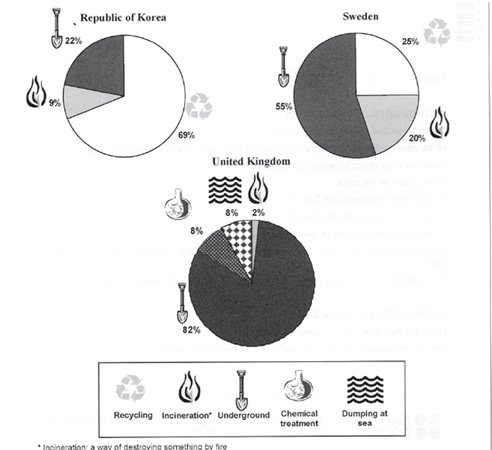The pie charts below show how dangerous waste products are dealt with in three countries.
The pie charts compare the amount of harmful waste products managed using 5 different methods, namely recycling, incineration, underground, chemical treatment and dumping at sea in three countries.
It is clear that there are only three ways used to deal with dangerous useless products in South Korea and Sweden, while harmful waste output in the UK is managed by using 4 different types of methods. The proportion of those products managed using underground waste disposal method in the UK is the highest number in all three countries.
In the UK, the largest proportion of dangerous waste products, 82% is managed by underground solution. Also, over half of those products are dealt with by using the same way in Sweden, compared to only 22% of those waste output in South Korea. On the other hand, recycling solution contributes to over two-thirds of South Korea's dangerous waste management methods, while there is only 25% of those waste output is recycled in Sweden.
The least common form of destroying dangerous waste products is using fire in South Korea, Sweden and the UK, about 9%, 20%, 22% of those products respectively. The figures for the UK's dangerous waste output are managed by using chemical treatment and dumping at sea are about 8% each.
-----------Thank you!-----------
Violet.
The pie charts compare the amount of harmful waste products managed using 5 different methods, namely recycling, incineration, underground, chemical treatment and dumping at sea in three countries.
It is clear that there are only three ways used to deal with dangerous useless products in South Korea and Sweden, while harmful waste output in the UK is managed by using 4 different types of methods. The proportion of those products managed using underground waste disposal method in the UK is the highest number in all three countries.
In the UK, the largest proportion of dangerous waste products, 82% is managed by underground solution. Also, over half of those products are dealt with by using the same way in Sweden, compared to only 22% of those waste output in South Korea. On the other hand, recycling solution contributes to over two-thirds of South Korea's dangerous waste management methods, while there is only 25% of those waste output is recycled in Sweden.
The least common form of destroying dangerous waste products is using fire in South Korea, Sweden and the UK, about 9%, 20%, 22% of those products respectively. The figures for the UK's dangerous waste output are managed by using chemical treatment and dumping at sea are about 8% each.
-----------Thank you!-----------
Violet.

WasteDisposal_Pie.pn.png
